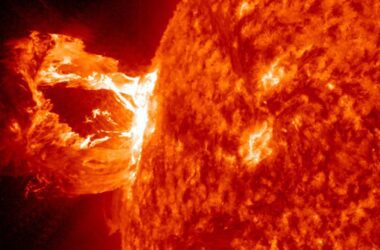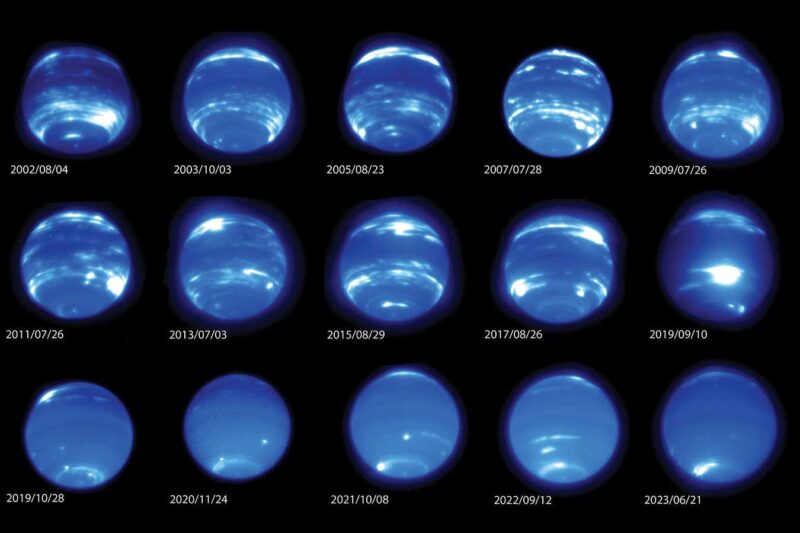Changes in cloud cover on Neptune from 2002 to 2023
Imke de Pater, Erandi Chavez, Erin Redwing (UC Berkeley)/W. M. Keck Observatory
The clouds on Neptune have dissipated. Its cerulean disc had been crisscrossed by wispy white clouds when the Voyager 2 probe captured its first detailed photographs in 1989, but the skies are now nearly entirely clean. Despite Neptune’s great distance from the sun, astronomers suspect that the number of clouds on the planet is controlled by the sun’s 11-year cycle.
From 1994 until 2022, Erandi Chavez and her colleagues at the University of California, Berkeley monitored the cloud activity on Neptune. They looked at old pictures taken by the Hubble Space Telescope and two terrestrial telescopes. The quantity of cloud cover was discovered to vary on a regular basis by the researchers; they observed that conditions were more foggy in 2002 and 2015, and more clear in 2007 and 2020.
Without any white clouds to reflect sunlight, Neptune was as dark as it has ever been observed in 2020, when cloud cover was at its lowest. Even now, Chavez stated in a statement, “the clouds haven’t returned to their former levels.” The most current photographs were taken in June. In the past, Neptune had periods of low cloud activity, but nothing like this.
The speed with which the shifts occurred was also unexpected, especially in 2019. “I was surprised by how quickly clouds disappeared on Neptune,” said Imke de Pater, also from the University of California, Berkeley, and a member of the team. Within just a few months, cloud cover decreased dramatically.
This pattern appears to be consistent with Neptune’s 11-year orbital period around the sun, but with a two-year lag between solar maximum and minimum. It appears that cloud formation on Neptune increases during solar maximum and decreases during solar minimum.
The energy from the sun might spark chemical reactions in the upper atmosphere of Neptune, causing clouds of methane and other compounds to form. Those chemical processes take time, which is why we have to wait two years. Neptune is so far from the sun that it receives only 1% of the sunlight that Earth does, so the sun appears more like a really bright star in the night sky than the blinding orb that we view from Earth, making the correlation seem even more odd.
There hasn’t been conclusive evidence to support the link yet. Sunlight could trigger the reactions that produce Neptune’s clouds, but it could also darken the clouds and hazes, so the relationship between the two may not be so direct.
In addition, the significance of Neptune’s massive storms, which develop low in the planet’s atmosphere and then ascend to the planet’s surface, is unknown. Scientists will keep an eye on Neptune until they fully understand its cloud structure.
FAQs
- Why have Neptune’s clouds disappeared?
- The clouds on Neptune have dissipated over time, and astronomers suspect a connection with the sun’s 11-year cycle.
- How did researchers monitor Neptune’s cloud activity?
- Researchers from the University of California, Berkeley, analyzed images from the Hubble Space Telescope and terrestrial telescopes taken between 1994 and 2022.
- Did cloud cover on Neptune show variations over time?
- Yes, the researchers observed regular variations in cloud cover. Conditions were foggier in some years, like 2002 and 2015, and clearer in others, like 2007 and 2020.
- What could be causing the fluctuations in cloud cover?
- Astronomers suspect that the sun’s energy might trigger chemical reactions in Neptune’s upper atmosphere, leading to cloud formation.
- Is there a connection between Neptune’s cloud activity and the sun’s 11-year cycle?
- The cloud formation pattern seems consistent with Neptune’s 11-year orbital period around the sun, with cloud cover increasing during solar maximum and decreasing during solar minimum.







